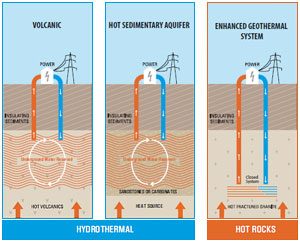
Geothermal energy is not a new concept, but it is relatively new to Australia. This section is designed to tell you about what it is, how it works and the kinds of geothermal energy that are under development in Australia.
What is geothermal energy?
Geothermal energy (from Greek roots geo, meaning earth, and thermos, meaning heat) is the energy stored as heat in the earth.
Energy is brought to the surface by extracting hot water that is circulating amongst the sub surface rocks, or by pumping cold water into the hot rocks and returning the heated water to the surface, to drive steam turbines to produce electricity.
Alternatively geothermal energy can be used directly for heating and cooling; in industry and agriculture, and domestically.
Sources of geothermal energy
In Australia, three types of projects are under development - they are Enhanced Geothermal Systems (EGS or hot rocks); Hot Sedimentary Aquifers (HSA); and direct use projects.

Enhanced Geothermal Systems (EGS) or Hot Fractured Rocks
The process to generate electricity from hot rocks is simple. In a very basic set up, two deep wells are drilled up to 5 kilometres below the surface using land based drilling rigs - similar to those which are used for oil and gas production - and the deep underlying rock structures are fractured to enhance the flow off water between the wells.
Water is pumped down one well (the injection well) from ground level, then through very hot, fractured rocks, typically granite or sedimentary sandstones, and up the other well (the production well) to the surface of the Earth. When the water gets to the surface it is very hot. It is moved through a turbine which converts the water to electricity.
Hot Sedimentary Aquifer (HSA)
HSA systems are typically developed in naturally occurring porous sandstones containing water that is heated by either crustal heat flow or proximate hot rocks. Fracturing techniques may still be used to enhance water flow between wells and HSA systems have been successfully operating in Australia and internationally for decades.
Direct Use Systems
Direct use is when the heat from underground water is used directly for applications such as heating and cooling buildings, industrial processes, greenhouses and aquaculture. Research is being undertaken at the WA Geothermal Centre of Excellence on advancing direct use applications.
Water Use
As water that is used in the geothermal energy process must be retained within a closed loop system to maintain pressure, geothermal projects require very little water to function.
Power Plant Technology
Geothermal energy development requires conventional technology for drilling and for power generation, but as Australia is a very hot place, our scientists and engineers are learning how to push technology to the limit to improve plant efficiencies and get the best performance in our extreme conditions.
Australia’s geothermal technologies
While four geothermal energy generation technologies exist, Australia’s conditions are suited to the following three sources:
- Hot Sedimentary Aquifer (HSA)
- Enhanced Geothermal Systems (EGS)
- Direct Use Projects
The third source, referred to as a “conventional” or “volcanic” system is the most common current form of geothermal production around the world but as Australia’s natural landscape is not host to active volcanoes, it is unlikely to be relevant here.
